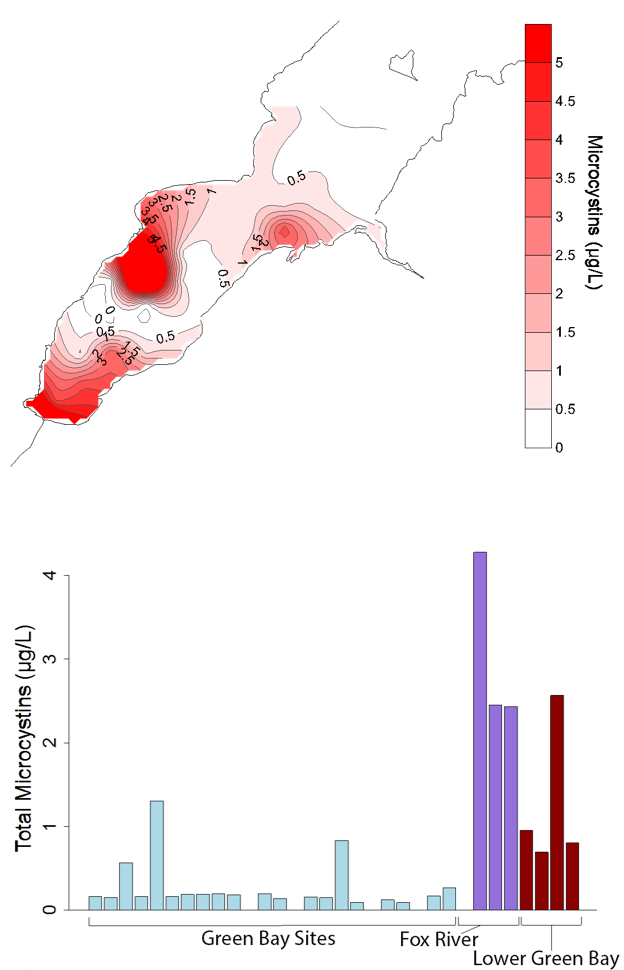Summer 2017 eNewsletter
Partner Research Feature
Tackling the HAB Problem in Green Bay, Lake Michigan

Figure 1: A late-season cyanobacterial bloom turns the surface of the water into a neon green ‘pea soup’ and can often be laden with toxins produced by cyanobacteria.
Although Green Bay contains only a small fraction – 1.4% – of the water in Lake Michigan, it is burdened with a third of the nutrients that enter the lake and degrade water quality. The resulting algae blooms and low oxygen “dead zones”, or hypoxia, have plagued the Green Bay for most of the last century and contributed to lower Green Bay’s designation as a Great Lakes Area of Concern (AOC). Nearly $1 billion has been invested in cleaning up Green Bay, but it has primarily targeted the removal of polychlorinated biphenyls, or PCBs, that contaminate the lake bottom from historical paper mill operations.
Despite the long-time problem of cyanobacterial harmful algal blooms, or cyanoHABs, in Green Bay, there is a surprising lack of information on cyanoHAB growth and toxicity in Green Bay. Much more is known about cyanoHABs in other areas of the Great Lakes, like western Lake Erie and Saginaw Bay. Not only do cyanoHABs cause ecological and economic problems, they create public health concerns stemming from their ability to produce compounds that can be toxic to humans and animals.

Figure 2. (Top) Microcystins (µg/L) were measured across Green Bay during August 2014. A deeper red color indicates a higher concentration of Microcystins. (Bottom) Total MCs measured from samples collected in 2015 show Lower Green Bay samples (dark red) had higher concentrations of MCs than samples from other Green Bay sites (blue).
Sarah Bartlett, a 2016-17 CIGLR Great Lakes Graduate Research fellow at the University of Wisconsin-Milwaukee School of Freshwater Sciences (UWM-SFS), and her advisor, Dr. Todd Miller, have been conducting research in Green Bay to not only identify the dominant cyanobacterial toxins produced there, but also to genetically identify the cyanotoxin producers (Figure 1). From samples collected throughout Green Bay, Bartlett and Miller’s preliminary data show that lower Green Bay contains high concentrations of microcystins (MCs) (Figure 2).
In addition to assessing the diversity of twenty different cyanobacterial toxins, other measured variables included major algal pigments (chlorophyll-a and phycocyanin), nutrients, cyanobacterial taxa counts, and water quality data. Their study will advance our understanding of cyanoHABs and their toxins in Green Bay through the use of advanced molecular and chemical techniques. This information will ultimately be used to help develop cyanoHAB prediction tools similar to those currently being used in Lake Erie.
About the Author
Sarah Bartlett was a CIGLR Graduate Research Fellowship recipient in 2016-2017, and is currently a Ph.D. candidate at the University of Wisconsin-Milwaukee’s School of Freshwater Sciences (UWM-SFS). Her fellowship with CIGLR provided Sarah a great opportunity to join a collaborative research project in Green Bay assessing cyanobacterial harmful algal blooms, working with several local and federal agencies including WI-DNR, NOAA-GLERL, USGS, NEW Water, and UW-Milwaukee.
Sarah recently accepted a position as the Water Resources Specialist for NEW Water, the Green Bay Metropolitan Sewerage district in Green Bay, WI. She will be continuing NEW Water’s Aquatic Monitoring Program, one of the longest monitoring efforts in the Great Lakes, in addition to collaborating on other research opportunities in the Bay.
Related Articles & Resources
- HABs Collaboratory 2017 Field Season, Great Lakes Commission (Webinar)
- HABs Collaboratory 2016 End of Field Season Wrap-Up, Great Lakes Commission (Webinar)
- In the News:
- Algae that produces toxins shows up early in Green Bay; WFRV Channel 5, 08/02/2017
- Experts Work to Save Green Bay: Up Front with Mike Gousha; WISN 12 News, 07/29/2017
